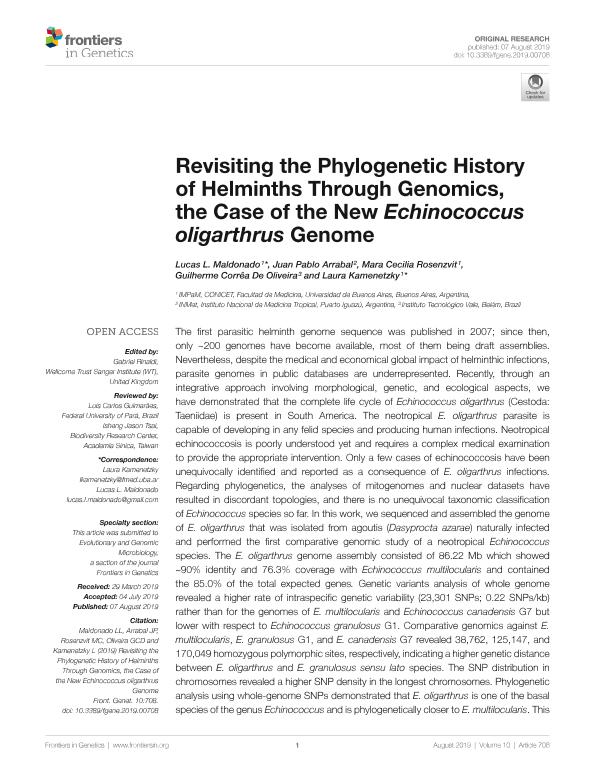Mostrar el registro sencillo del ítem
dc.contributor.author
Maldonado, Lucas Luciano

dc.contributor.author
Arrabal, Juan Pablo

dc.contributor.author
Rosenzvit, Mara Cecilia

dc.contributor.author
De Oliveira, Guilherme Corrêa
dc.contributor.author
Kamenetzky, Laura

dc.date.available
2021-04-16T16:56:20Z
dc.date.issued
2019-08
dc.identifier.citation
Maldonado, Lucas Luciano; Arrabal, Juan Pablo; Rosenzvit, Mara Cecilia; De Oliveira, Guilherme Corrêa; Kamenetzky, Laura; Revisiting the phylogenetic history of helminths through genomics, the case of the new echinococcus oligarthrus genome; Frontiers Media S.A.; Frontiers in Genetics; 10; JUL; 8-2019; 1-13
dc.identifier.issn
1664-8021
dc.identifier.uri
http://hdl.handle.net/11336/130223
dc.description.abstract
The first parasitic helminth genome sequence was published in 2007; since then, only ~200 genomes have become available, most of them being draft assemblies. Nevertheless, despite the medical and economical global impact of helminthic infections, parasite genomes in public databases are underrepresented. Recently, through an integrative approach involving morphological, genetic, and ecological aspects, we have demonstrated that the complete life cycle of Echinococcus oligarthrus (Cestoda: Taeniidae) is present in South America. The neotropical E. oligarthrus parasite is capable of developing in any felid species and producing human infections. Neotropical echinococcosis is poorly understood yet and requires a complex medical examination to provide the appropriate intervention. Only a few cases of echinococcosis have been unequivocally identified and reported as a consequence of E. oligarthrus infections. Regarding phylogenetics, the analyses of mitogenomes and nuclear datasets have resulted in discordant topologies, and there is no unequivocal taxonomic classification of Echinococcus species so far. In this work, we sequenced and assembled the genome of E. oligarthrus that was isolated from agoutis (Dasyprocta azarae) naturally infected and performed the first comparative genomic study of a neotropical Echinococcus species. The E. oligarthrus genome assembly consisted of 86.22 Mb which showed ~90% identity and 76.3% coverage with Echinococcus multilocularis and contained the 85.0% of the total expected genes. Genetic variants analysis of whole genome revealed a higher rate of intraspecific genetic variability (23,301 SNPs; 0.22 SNPs/kb) rather than for the genomes of E. multilocularis and Echinococcus canadensis G7 but lower with respect to Echinococcus granulosus G1. Comparative genomics against E. multilocularis, E. granulosus G1, and E. canadensis G7 revealed 38,762, 125,147, and 170,049 homozygous polymorphic sites, respectively, indicating a higher genetic distance between E. oligarthrus and E. granulosus sensu lato species. The SNP distribution in chromosomes revealed a higher SNP density in the longest chromosomes. Phylogenetic analysis using whole-genome SNPs demonstrated that E. oligarthrus is one of the basal species of the genus Echinococcus and is phylogenetically closer to E. multilocularis. This work sheds light on the Echinococcus phylogeny and settles the basis to study sylvatic Echinococcus species and their developmental evolutionary features.
dc.format
application/pdf
dc.language.iso
eng
dc.publisher
Frontiers Media S.A.

dc.rights
info:eu-repo/semantics/openAccess
dc.rights.uri
https://creativecommons.org/licenses/by-nc-sa/2.5/ar/
dc.subject
CHROMOSOMES
dc.subject
ECHINOCOCCUS OLIGARTHRUS
dc.subject
GENOME
dc.subject
PARASITES
dc.subject
PHYLOGENY
dc.subject
SINGLE NUCLEOTIDE POLYMORPHISM
dc.subject.classification
Parasitología

dc.subject.classification
Ciencias de la Salud

dc.subject.classification
CIENCIAS MÉDICAS Y DE LA SALUD

dc.title
Revisiting the phylogenetic history of helminths through genomics, the case of the new echinococcus oligarthrus genome
dc.type
info:eu-repo/semantics/article
dc.type
info:ar-repo/semantics/artículo
dc.type
info:eu-repo/semantics/publishedVersion
dc.date.updated
2020-12-18T19:32:53Z
dc.journal.volume
10
dc.journal.number
JUL
dc.journal.pagination
1-13
dc.journal.pais
Suiza

dc.description.fil
Fil: Maldonado, Lucas Luciano. Consejo Nacional de Investigaciones Científicas y Técnicas. Oficina de Coordinación Administrativa Houssay. Instituto de Investigaciones en Microbiología y Parasitología Médica. Universidad de Buenos Aires. Facultad de Medicina. Instituto de Investigaciones en Microbiología y Parasitología Médica; Argentina
dc.description.fil
Fil: Arrabal, Juan Pablo. Ministerio de Salud. Instituto Nacional de Medicina Tropical; Argentina
dc.description.fil
Fil: Rosenzvit, Mara Cecilia. Consejo Nacional de Investigaciones Científicas y Técnicas. Oficina de Coordinación Administrativa Houssay. Instituto de Investigaciones en Microbiología y Parasitología Médica. Universidad de Buenos Aires. Facultad de Medicina. Instituto de Investigaciones en Microbiología y Parasitología Médica; Argentina
dc.description.fil
Fil: De Oliveira, Guilherme Corrêa. Instituto Tecnológico Vale.; Brasil
dc.description.fil
Fil: Kamenetzky, Laura. Consejo Nacional de Investigaciones Científicas y Técnicas. Oficina de Coordinación Administrativa Houssay. Instituto de Investigaciones en Microbiología y Parasitología Médica. Universidad de Buenos Aires. Facultad de Medicina. Instituto de Investigaciones en Microbiología y Parasitología Médica; Argentina
dc.journal.title
Frontiers in Genetics
dc.relation.alternativeid
info:eu-repo/semantics/altIdentifier/url/https://www.frontiersin.org/article/10.3389/fgene.2019.00708/full
dc.relation.alternativeid
info:eu-repo/semantics/altIdentifier/doi/http://dx.doi.org/10.3389/fgene.2019.00708
Archivos asociados
